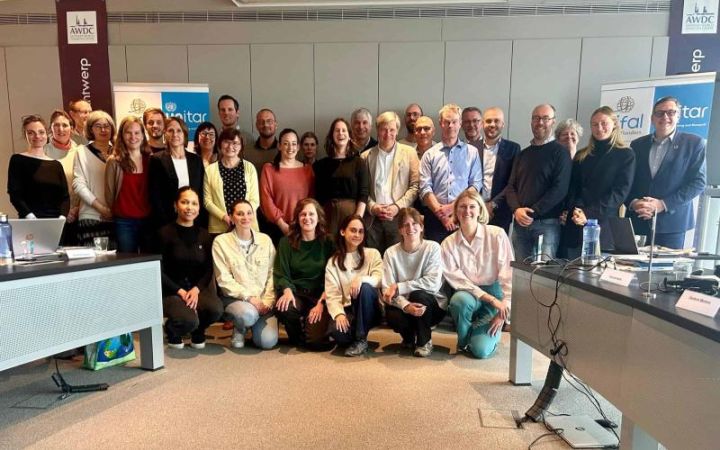Today, new results from a pre-specified, patient level, pooled analysis from the Phase III DAPA-HF and DELIVER trials demonstrated mortality benefit of Farxiga (dapagliflozin), compared to placebo, in patients with heart failure (HF). These results were presented at the European Society of Cardiology Congress 2022 in Barcelona, Spain and simultaneously published in Nature Medicine1. The reduction in risk of cardiovascular (CV) death was consistent across pre-specified subgroups and is the first analysis to demonstrate a mortality benefit with a HF medication in patients with HF across the left ventricular ejection fraction (LVEF) range.
The analysis showed that Farxiga reduced the risk of CV death by 14% (p=0.01, absolute risk reduction [ARR] 1.5%) over the median follow-up of 22 months, death from any cause by 10% (p=0.03, ARR 1.5%), total (first and repeat) hospitalisation for HF by 29% (p 1.
Prof. John McMurray, Professor of Medical Cardiology and Deputy Director of the Institute of Cardiovascular and Medical Sciences at the University of Glasgow, UK, said: “In this patient-level meta-analysis including over 11,000 patients with heart failure across the full range of ejection fraction, dapagliflozin reduced the risk of both cardiovascular death and heart failure hospitalisation. These results underpin the valuable role dapagliflozin can play in clinical practice, as we can initiate treatment right away while waiting for ejection fraction to be measured.”
Mene Pangalos, Executive Vice President, BioPharmaceuticals R&D, AstraZeneca, said:
“Heart failure remains one of the leading causes of death worldwide with high unmet need for some 64 million people. This analysis demonstrates Farxiga’s ability to treat patients across the full left ventricular ejection fraction spectrum and reduce the risk of cardiovascular death.”
The DAPA-HF and DELIVER Phase III trials were randomised and double-blind, comparing Farxiga to placebo. Each trial enrolled patients with a diagnosis of HF, functional limitation, and elevated natriuretic peptides. The principal difference between the two trials was that patients with an LVEF of 40% or less were randomised in DAPA-HF and those with a LVEF greater than 40% in DELIVER3,4. The studies included 11,007 individuals with HF across 20 countries in each trial.
Notes
HF
HF is a chronic, long-term condition that worsens over time5. It affects nearly 64 million people globally and is associated with substantial morbidity and mortality6,7. Chronic HF is the leading cause of hospitalisation for those over the age of 65 and represents a significant clinical and economic burden8. There are several types of HF often defined by LVEF, a measurement of the percentage of blood leaving the heart each time it contracts, including: HF with reduced EF (HFrEF, LVEF less than or equal to 40%), HF with mildly reduced EF (HFmrEF, LVEF 41-49%) and HF with preserved EF (HFpEF, LVEF greater than or equal to 50%)9. Approximately half of all HF patients have HFmrEF or HFpEF, with few therapeutic options available9,10.
DAPA-HF
DAPA-HF (Dapagliflozin And Prevention of Adverse-outcomes in Heart Failure) was an international, multi-centre, parallel-group, randomised, double-blinded Phase III trial in 4,744 patients with HFrEF, with and without type-2 diabetes (T2D), designed to evaluate the effect of Farxiga 10mg, compared with placebo, given once daily in addition to standard of care (SoC) consisting of an angiotensin-converting enzyme inhibitor (ACEi) or an angiotensin receptor blocker (ARB). The primary composite endpoint was time to the first occurrence of a worsening HF event (hospitalisation or equivalent event, i.e. an urgent HF visit), or CV death. The median duration of follow-up was 18.2 months2,4.
The secondary endpoint included the total number of hospitalisations for HF (hHF, including repeat admissions) and CV deaths, change from baseline to 8 months in the total symptom score on the Kansas City Cardiomyopathy Questionnaire (KCCQ)4.
DELIVER
DELIVER was an international, randomised, double-blind, parallel-group, placebo-controlled, event-driven Phase III trial designed to evaluate the efficacy of Farxiga, compared with placebo, in the treatment of HF patients with LVEF greater than 40%, with or without T2D. Farxiga was given once daily in addition to background therapy (regional SoC for all comorbidities, including diabetes and hypertension, with the exception of concomitant use of a sodium-glucose cotransporter 2 (SGLT2) inhibitor)3.DELIVER is the largest clinical trial to date in HF patients with LVEF above 40%, with 6,263 randomised patients1,3.
The primary endpoint was the time to first occurrence of CV death, hHF or an urgent HF visit. The secondary endpoint includes the total number of HF events (hHF or urgent HF visit) and CV death, change from baseline in the total symptom score of the KCCQ at eight months, time to the occurrence of CV death and time to the occurrence of death from any cause3.
Farxiga
Farxiga (dapagliflozin) is a first-in-class, oral, once-daily SGLT2 inhibitor. Research has shown Farxiga’s efficacy in preventing and delaying cardiorenal disease, while also protecting the organs – important findings given the underlying links between the heart, kidneys and pancreas4,11,12. Damage to one of these organs can cause the other organs to fail, contributing to leading causes of death worldwide, including T2D, HF and chronic kidney disease (CKD)6,13-15.
Farxiga is approved in adults and children aged 10 years and above for the treatment of insufficiently controlled type-2 diabetes mellitus as an adjunct to diet and exercise. Farxiga is also approved for the treatment of HFrEF and the treatment of CKD based on the findings of the DAPA-HF and DAPA-CKD Phase III trials.
DapaCare is a robust programme of clinical trials to evaluate the potential CV, renal and organ protection benefits of Farxiga. It includes more than 35 completed and ongoing Phase IIb/III trials in more than 35,000 patients, as well as more than 2.5 million patient-years’ experience. Farxiga is currently being tested in patients without T2D following an acute myocardial infarction or heart attack in the DAPA-MI Phase III trial – a first of its kind, indication-seeking registry-based randomised controlled trial.
AstraZeneca in CVRM
Cardiovascular, Renal and Metabolism (CVRM), part of BioPharmaceuticals, forms one of AstraZeneca’s main disease areas and is a key growth driver for the Company. By following the science to understand more clearly the underlying links between the heart, kidneys and pancreas, AstraZeneca is investing in a portfolio of medicines for organ protection and improving outcomes by slowing disease progression, reducing risks and tackling co-morbidities. The Company’s ambition is to modify or halt the natural course of CVRM diseases and potentially regenerate organs and restore function, by continuing to deliver transformative science that improves treatment practices and CV health for millions of patients worldwide.
AstraZeneca
AstraZeneca (LSE/STO/Nasdaq: AZN) is a global, science-led biopharmaceutical company that focuses on the discovery, development, and commercialisation of prescription medicines in Oncology, Rare Diseases, and BioPharmaceuticals, including Cardiovascular, Renal & Metabolism, and Respiratory & Immunology. Based in Cambridge, UK, AstraZeneca operates in over 100 countries and its innovative medicines are used by millions of patients worldwide. Please visit astrazeneca.com and follow the Company on Twitter @AstraZeneca.








